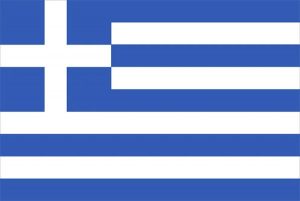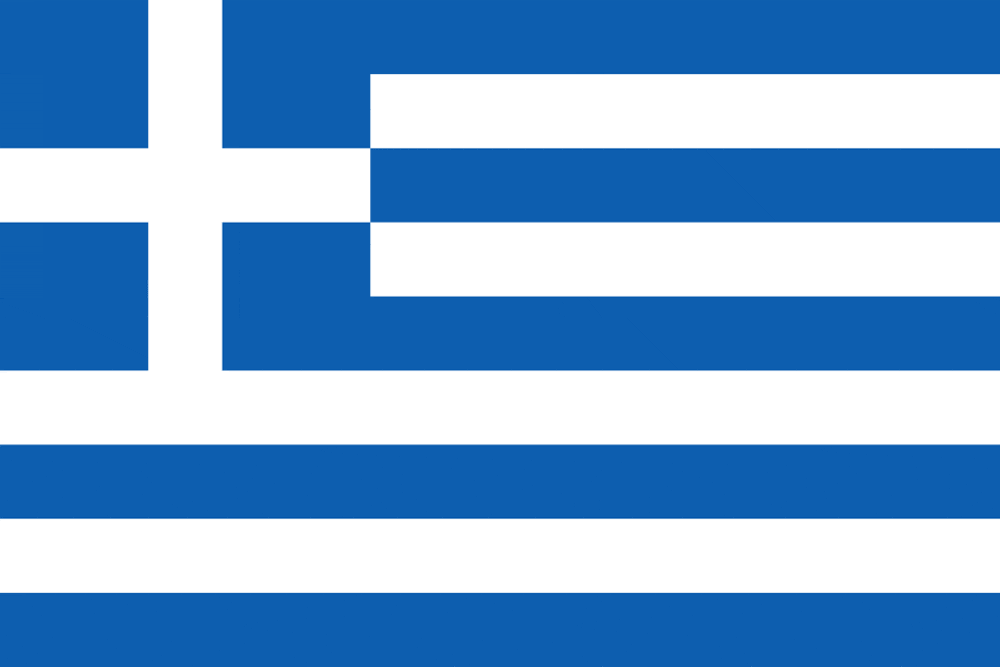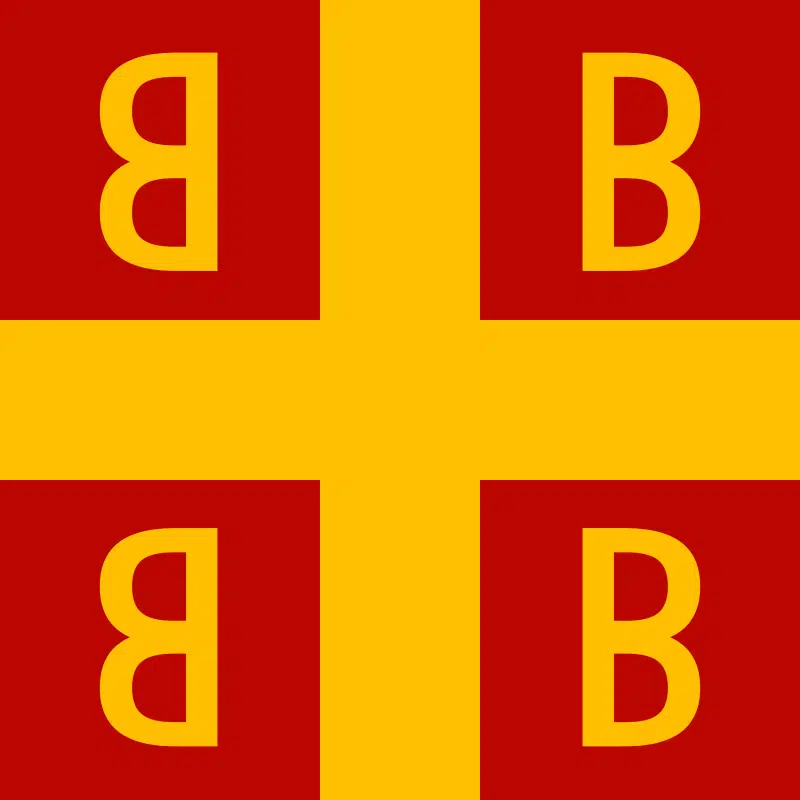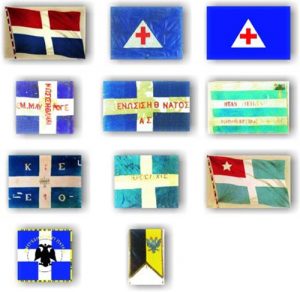The Greek flag meaning and history
 The flag of Greece is not merely a piece of fabric; it is a powerful symbol that encapsulates the nation’s history, culture, and unwavering spirit. The blue and white colors, the cross, and the nine stripes collectively tell the story of a nation’s struggle for independence, its deep religious roots, and its enduring commitment to freedom and identity. As the flag continues to fly proudly over the country, it serves as a reminder of the enduring legacy and resilience of the Greek people.
The flag of Greece is not merely a piece of fabric; it is a powerful symbol that encapsulates the nation’s history, culture, and unwavering spirit. The blue and white colors, the cross, and the nine stripes collectively tell the story of a nation’s struggle for independence, its deep religious roots, and its enduring commitment to freedom and identity. As the flag continues to fly proudly over the country, it serves as a reminder of the enduring legacy and resilience of the Greek people.
The Greek flag is called “Galanolefki” which means “blue and white”. Originally it was blue with a white diagonal cross. The cross is now situated in the upper left corner, and symbolizes the Christian faith.
The Greek flag, as it stands, adopted by the First National Assembly of Epidaurus, which was convened in 1822.
The need to build a certain flag for the new born state, was presented with the beginning of the Greek Revolution of 1821 and when the Greeks achieved their first victories against the Ottomans This was needed even as a means of rallying among all the groups and chieftains, who until then they had their own flags and pennants.
There are many speculations about the origins of the colours and the shape of the Greek flag. Some of them they say that the white and blue colour symbolized the uniforms of the revolution fighters (White kilts of fighters in the mainland and blue baggy trousers of the seafarers).
It is also said that the white symbolizes the foam of the waves and the blue the sky of Greece. In addition alleged that white was the naval flag of the Greek islands, at the beginning of the revolution. Another speculation is that blue is the colour of the sea, and Greece being a seafarers country, it could hardly have any other colour. Blue is also a lucky colour, which will ward off evil according to superstition. White is the colour of freedom, and that is something the Greeks hold very dear after years of enslavement under the Turks. However, we can’t say definitely from were came from the colours of the Greek flag. The nine stripes each symbolize a syllable in the Greek motto of freedom: E-LEY-THE-RI-A-I-THA-NA-TOS, which translates Freedom or Death. For the nine stripes there are also different opinions, of which the most appropriate is probably the one that says that in ancient times the number nine was sacred.
During the reign of τηε Bavarian kin Otto who was imposed in Greece in 1830, the royal medals were added to the flag of the army and navy. The trade flag was set to be like the flag of the navy, without the medals.
In 1862, with the overthrow of Otto’s reign, the royal medals were removed from the flags. During the reign of George I, the royal crown was added to the flags of the army and navy.
In 1864, the infantry flag was set to carry in its center the image of Saint George, patron saint of the infantry. On March 25, 1924, the Ministries of Defense and Navy removed the crowns from the flags, executing the resolution of the Fourth Constituent Assembly in Athens on the proclamation of the Republic.
The official flag was set to be used by ministries, embassies, public or municipal services and fortresses, and the national flag by warships and merchant ships, naval and port stores and institutions, consulates and individuals.
On October 10, 1935, the crowns were restored to the flags with the resolution of the National Assembly in Athens On the abolition of the reigning Republic. In 1967, the divtatorship of the Colonels removed the crown from the flags, and in 1969 a new resolution abolished the infantry flag and established it as the official flag of the Navy. After the change of government in 1974 regulated in detail the shape and dimensions of the flag as is today.

FLAG OF GREECE

History of the Greek Flag

In all these rebellions, a flag was raised, “en panion”, an impromptu invention of each leader, a normal fact since there was no single state entity to impose a common emblem.
Most flags had some common characteristics (Byzantine purple, double-headed or single-headed eagle, etc.), with the most important of all being the cross, because the Church was the main rallying factor of the Greeks during the Turkish rule.
Very quickly the cross was imposed as the religious and political emblem of the subjugated nation, to such an extent that clerics led rebellions using the sacred banners of their churches as flags.
At the beginning of the Revolution of 1821, many flags appeared with various representations, according to the imagination of each leader, based on his hatred of the Turks, his historical knowledge, family traditions and religious piety.
Immediately after the capture of Tripolitsa, Papaflessas cut a piece from the inner side of his waistcoat and at the same time asked the chieftain Panagiotis Kephalas to tear two strips from his white shirt.
The history of the first post-revolutionary years also gave a romantic dimension to the flag, the result of a collaboration between a soldier and a priest, stating that the thief’s bravery supported her hopes in the Christian faith.
On January 1, 1822, the First National Assembly convened in Piada, Epidaurus. Among the many things that were discussed was the question of establishing a single revolutionary flag, in order to stop the confusion that prevailed until then from the appearance of dozens of flags.
With an Article of the Provisional Government of Greece, the uniform flag was defined to symbolize “God’s wisdom, Freedom and the Motherland” and it was established that it should bear the cross as a symbol and the colors blue and white. On March 15, 1822 in Corinth, the Executive Body by Decree 540 specified the details of the above decision.
The flag of the “powers against the earth” would be square, blue in color, with a white cross in the middle. The naval flag was distinguished into war and commercial. The polemic was divided into nine horizontal parallelograms. In its upper inner corner was a blue square with a white cross in the middle.
The above was also approved and ratified by the Political Constitution of Greece in Troizina (May 1827), stipulating that the Greeks should not use other flags both on land and at sea. The above order was applied universally at first, as it clashed with the strong local spirit of the revolutionaries.
Gradually, however, blue and white prevailed, ending the confusion due to the various colors and shapes. On July 30, 1828, the governor Ioannis Kapodistrias issued a resolution according to which “the warships and merchant ships of Greece want to fly the same flag, the one that has been of war until today”, thus restoring a great injustice against the Greek merchant fleet. who had borne the brunt of the Struggle for Independence.
As for the reasoning behind the choice of colors (white and blue), the series and the symbols that were sought, there are various opinions, which even today lead to a dichotomy among historians.
With the choice of blue, the color of the sky, the divinity of the Struggle is indicated, since God inspired the nation with the great idea, although weak and unarmed, to undertake and bring to a happy end that unequal struggle.
White signifies the clean, innocent and pure purpose of the Greeks whose only pursuit was the liberation and independence of the nation and its liberation from the long-standing cruel tyranny. Besides, according to the prevailing version, the nine blue and white bands represent the nine syllables of the phrase “Liberty or Death”, which was also the oath of the lads of the Revolution”.
What is certain is that in none of the official government documents, through which the flag in question was established, there is no justification for this particular color choice and shape. It seems that the blue and white still keeps its secrets well hidden. However, it continues to inspire.

The struggle between the official and the revolutionary flags of Greece
Rreading the history of the establishment of the Greek flag, another question should arise in our minds. Why didn’t the fathers of the Greek nation decide to use the flag of Philiki Etairia (Friendly Society), or even of Alexandros Ypsilantis, as an official flag?
Unlike the previous questions, which can only be answered with guesses, here we can give clear and specific answers.
The 1st National Assembly of Epidaurus, putting above all the interests of the Greek Nation – in order to preserve the purpose of the struggle and to reverse the false impression that was initially created in the courtyards of Europe and especially in the bosom of the Holy Alliance for the Revolution took the decision to eliminate all the friendly and Byzantine symbols that until then carried the flags of the Revolution, alongside the refusal of the Revolutionary Directorate to accept Italian “libertarian” volunteers into the struggle, thus projecting to European governments that the Revolution was a purely liberating struggle. Apart from this view of Spyridonos Trikoupis, there is also the oral tradition of the Etarists, which is expressed in Sakellarios G. Sakellario’s book ”Friendly Society”, which was published in Odessa in 1909.
After the establishment of the official flag, however, the use of the various revolutionary flags did not cease until several years later. The most “stubborn” revolutionary flags were the colorful flags of Roumeli and the flag of the Supreme Court, which had even persistently requested the use of its idiosyncratic flag in its territory, giving a relevant order “Prevent the tricolor flag from being circulated in the district of the Supreme Court but only the National” to his proxy, Georgios Ainiana, who would go to the Assembly of the Chiliarchs and other leaders of the Peloponnese and Central Greece on March 6, 1822. Dimitrios Ypsilantis, wanting to gather the reactions, on the 9 April 1822 he writes from Dadi to the Parliament the following wise words:
“Regarding the form and color of the flag, whatever the reasons of the modernizers may have been, they never opposed, nor do I oppose, I consider the salvation of Greece not in the colors, but in the actions and in the apathy and sincere dedication to the common benefit and glory of the nation. In fact, they see here flags of various kinds, some white and some of various colors, and considering that it is neither convenient nor necessary for such dissimilarity, I ordered that all should follow the new one. However, it is necessary to enough of this should be prepared and sent to the various military corps, “that the Parliament should write about them on Arios Pagos”.
The colors of the flag are also repeated in the Law of Epidaurus from the Second National Assembly in Astros in 1823, emphasizing at the same time the end of the use of revolutionary flags. However, while we would expect the diversity of the flags to disappear at the end of the Struggle, this does not happen, since in the Political Constitution of Greece, which was drawn up by the 3rd National Assembly of Troizina (May 1, 1827), we again find a similar mention of the flag.
Changes to the Greek flag
 Since its establishment, in March 1822, until today, the Greek flag has undergone various minor modifications, which mainly reflected the constitutional changes of the country’s constitution. Below we will examine the main ones.
Since its establishment, in March 1822, until today, the Greek flag has undergone various minor modifications, which mainly reflected the constitutional changes of the country’s constitution. Below we will examine the main ones.
On July 30, 1828, with Resolution IV, no. 3529, the governor Ioannis Kapodistrias takes the decision of assimilating the flag of commercial ships with that of warships, since it was a great injustice for commercial ships, which offered equal services to the state, to fly a different flag. With a Royal Decree on April 4, 1833, King Othona regulates the issue of naval flags in more detail.
On April 20, 1841, with the Order No. 3658 of the Secretariat of the Navy of the State, the details of the construction and dimensions of the flags are regulated, while with a Royal Decree of August 28, 1858 (On the Greek military and commercial flag) it is arranged the use of the various insignia of the war and commercial flag, as well as the hoisting points and the dimensions and proportions of the flags.
On 28 December 1863, King George I issued a new Royal Decree, which defined the shape and proportions of the official royal flag, adding the royal crown to the center of the cross of the Naval and Fort flags, while the royal flag would bear in the middle of the cross the emblems of the state and the coats of arms of the royal family.
Also, with a Royal Decree, the battle flags of the Battalions were determined on April 9, 1864, maintaining to this day the same form, i.e. blue and white with a cross, silk with golden fringes all around – they symbolize the souls that the country trusts in the flag – and with the Saint on horseback George in the middle. The dimensions of the flags were also included in a new Royal Decree, issued on September 26, 1867.
On May 31, 1914, it was decided by a new Royal Decree that the flag of the Ministries, Embassies and Public-Municipal offices should bear a crown in the middle (that is, to be the same as that of the Fortresses), while private individuals were allowed to raise the merchant marine flag (identical with the polemic, but without the crown). Also, for the Army Units, it was established that only the Regiments of the Infantry and the Evzones should carry a war flag.
In April 1926, a War Flag was also awarded to the Military School of Hope, with the determination of its insignia in July of the same year and the addition and removal of the crown in subsequent years, depending on the state changes of the country. In 1938 the battle flags of the Infantry and Cavalry Regiments were detailed and battle flags were awarded to the newly formed Cavalry Regiments.
On March 25, 1924, the Ministries of Military and Naval, in order to implement the resolution of the 4th Constituent National Assembly in Athens “On the Proclamation of the Republic”, ordered the removal of the crowns from the flags, to be reinstated on October 10, 1935. when the 5th National Assembly in Athens decides on the Resolution “Regarding the Abolition of the Despotic Democracy”.
In April 1967, after the coup d’état seizure of power by the Junta, the crown was removed from the flags, while in 1969, with a new resolution, the land flag was abolished and the naval flag was established as official; although no specific shades of blue were specified, it was determined that all flags should be the same color as the “standards” of the two government agencies.
Judging from the flags made between 1970-1975, we have to conclude that the “standard” flags were somewhat dark in color. On August 18, 1970, the aspect ratio of the flag was changed from 2:3 to 7:12, making it somewhat narrower.
After the transition that came with the fall of the Junta in July 1974 and the establishment by referendum of the presidential parliamentary democracy, Law no. 48/1975 “On the national flag of Greece and the emblem of the Hellenic Republic”, while Presidential Decree 515/1975 regulates the details of its form and dimensions.
Although both of these documents make no reference to a “seaward” flag, they do not abolish it. Law 851/21-12-1978 (Government Gazette 233 Α΄) “On the National Flag, Military Flags and the Distinguishing Mark of the President of the Republic” defined the official national flag that we use to this day, as well as its technical and formal specifications .
Among them, it was decided that the short of the flags of private individuals, offices and shops should not bear a cross, contrary to the flags of public, municipal, educational and military authorities. In article 9, however, the provisions of the previous years (1967, 1969, 1971, 1973, 1975) are repealed, with the result that Law 48/1975 and PD 515/1975 are repealed, instead of supplemented, and together with the repeal of the first Greek flag, as it had been determined by the 1st National Assembly of Epidaurus and had remained unchanged for almost 156 years, through despotism, monarchy, kingship, dictatorship and democracy.
In 1980, with the Presidential Decree 348/17-4-1980 (Government Gazette 98 Α΄), the specifications for the manufacture of war flags were defined in detail. Generally speaking, after 1978 a lighter blue is used for Greek flags (compared to the Junta flags).
Symbolism of the Greek Flag
-
Blue and White Colors: The alternating blue and white stripes on the Greek flag are not arbitrary. Blue is associated with the sky and the sea, reflecting the geographical and historical significance of the Mediterranean region to Greece. White, on the other hand, represents purity and the waves of the sea.
-
Cross: The white cross in the blue square is a prominent feature of the flag, symbolizing the connection between the Greek Orthodox Church and the nation. It also signifies the historical influence of Christianity in shaping Greek culture and identity.
-
Nine Horizontal Stripes: The nine horizontal stripes on the flag represent the syllables in the phrase “Eleftheria i Thanatos,” meaning “Freedom or Death.” This phrase encapsulates the spirit of the Greek War of Independence and the determination of the Greek people to achieve freedom at any cost.
Greek Flag Usage and Protocol
The Greek flag is proudly displayed on various occasions, including national holidays, public events, and official ceremonies. It is also hoisted on public buildings, schools, and private residences throughout the country.
There are specific protocols for displaying the Greek flag, including proper folding and handling. Additionally, the flag is flown at half-mast during times of national mourning as a sign of respect.
